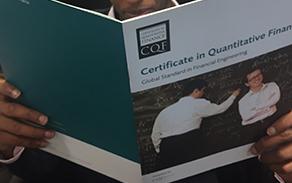In Conversation with CQF Alumni: Subrahmanyam Oruganti

Subrahmanyam Oruganti, Partner in FS Risk Advisory, EY
Subrahmanyam earned the CQF in 2010. He started his career at ICICI Bank, before becoming Partner in FS Risk Advisory for EY. We spoke to Subrahmanyam about starting his career when there were few quant roles in India, to becoming one of India’s leading quants.
Why did you decide to pursue your current career path?
I have always been interested in finance and mathematics since childhood. This led me to pursue an MBA in Finance from IIM Mumbai. After completing my MBA, I furthered my education by obtaining the CFA and FRM charters. These certifications gave me a strong foundation in quantitative finance and risk management. I am now working in quantitative risk management, where I use my skills to help businesses mitigate risk and make informed financial decisions.
How did you get to the senior level that you’re at today?
After graduating in 2007, there were very few opportunities to pursue a career in quantitative finance in India. However, I took the time to sharpen my skills in this area through the CQF program, which provided me with the knowledge and skills I needed to succeed in quantitative finance. I then started a job in the model validation team of a global investment bank. When more investment banks started moving quant roles to India, I was well-positioned to move to a more senior level.
What kind of work is involved in your current role?
I am currently the Head of Quant Advisory Services at a leading consulting firm in India. My role encompasses a wide range of responsibilities across the front office, market risk, liquidity risk, CCR, and credit risk domains. I provide risk and strategy consulting services in the areas of quantitative analysis, analytics, regulatory transformation, capital optimization, and trading strategies. In addition to my core responsibilities, I am also focused on building AI/ML solutions in these areas.
What do you enjoy most about the role?
In the current market environment, banks and financial institutions are under pressure to improve their risk quantification and profitability. This is due to several factors, including regulatory requirements, increased competition, and changing customer demands. Some banks are taking a regulatory-driven approach to risk quantification, focusing on compliance. Others are taking a strategic approach, using risk quantification to improve their profitability and decision-making. I find this work to be challenging and gratifying. It is challenging because it requires a deep understanding of the financial markets and the latest risk quantification techniques. It is gratifying to be able to help banks and financial institutions improve their risk management and profitability.
What are some of the major highlights in your career to date?
My career has progressed through several stages. I started as a software engineer in an IT company, then pursued an MBA from IIM and moved into the banking industry. I gained experience in derivatives pricing and risk management at an Indian bank. I then moved to global banks, where I have worked on model development and validation in several risk areas.
In 2017, I moved to a major consulting firm and became the lead of their quantitative advisory services. I have since had the opportunity to work with banks in the US, Europe, and Asia and to help solve their problems.
What have been some of the biggest challenges in your field of work over the past few years?
The most significant challenges I have faced are the different regulatory expectations across various regions. Additionally, the sophistication of clients across the globe varies greatly, making it challenging to cater to multiple clients with different priorities at the same time.
How have quant finance and the financial industry changed over the course of your career?
I remember a time when sophisticated models were created using Excel, which was a powerful and versatile tool in those days. However, the landscape has changed dramatically in recent years, driven by an unprecedented increase in data availability, rapid technological advances, new concepts, and increasing pressure to shorten time to market. As a result, the industry's evolution has expanded beyond traditional quantitative finance to include data science, artificial intelligence, and blockchain, which are all shaping the financial sector significantly.
How has the CQF added value in your career trajectory?
There were very few quantitative finance roles in India 15 years ago. The CQF program helped me to get my foot in the door and land a quant finance role at a global bank. This had a strong, positive impact on my career, and I am now considered to be one of the leading quantitative finance subject matter experts in India. I am regularly consulted by senior bankers on quantitative finance matters, and I am also a visiting professor at IIM Indore, where I teach a quantitative finance course.
What skillsets are required to be successful in quantitative finance today?
People must have strong mathematical skills, including stochastic and probability theory, as well as programming skills in C++ or Python. They should also have a strong understanding of capital markets. In addition, critical thinking, and strong communication skills are essential for any successful career in finance.
In addition, candidates should be conversant with the latest trends in machine learning and regulatory compliance. Machine learning is increasingly important in quantitative finance, as it can be used to develop more sophisticated trading strategies and risk models. Regulatory compliance is also a growing concern, as financial institutions face constant scrutiny from regulators.
What skills will become more important in the coming years? Will any of them be different from the ones needed now?
People need to focus on using AI/ML techniques to solve client problems and improve decision-making. This can help to raise profitability and to quantify and mitigate risk.
What advice would you offer to someone just starting their career in the financial industry?
My advice to anyone is to be very clear about their strengths and weaknesses. If you are strong in math and programming, then it makes perfect sense to pursue a career in quantitative finance. Otherwise, it would be better to pursue a career in another field in the financial industry. There is a serious shortage of talent in the financial industry across all areas (front office, risk, finance, IT, operations, etc.). If you become proficient in any of these areas, you will have a good career path. In addition, in any area of work, you should always have a flexible mindset and be willing to take on new challenges.
Find out more about the CQF program
To discover how the CQF program could help you go further in your career, download a brochure or register to join an information session.




